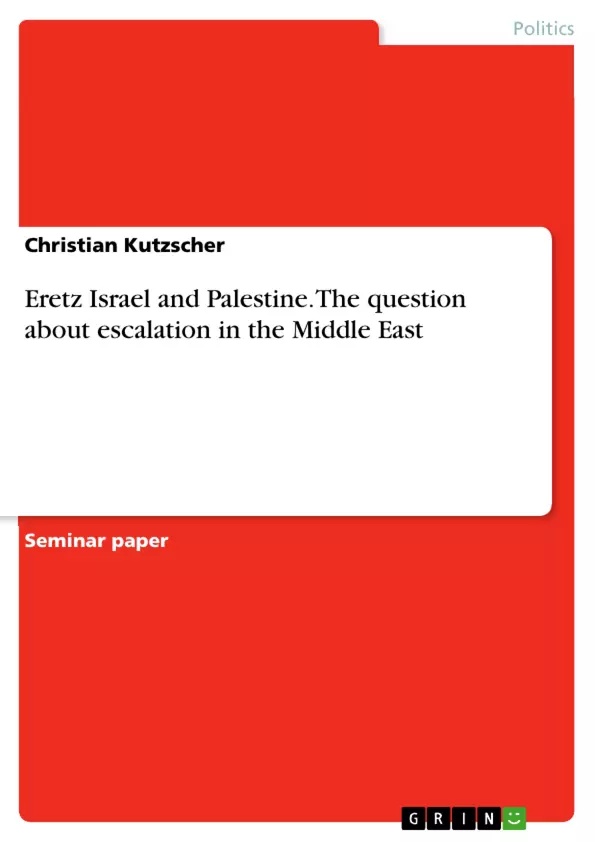This paper deals with the question if escalation of the Arab-Israeli conflict is inevitable, stating arguments on the theoretical basis of neorealism and trying to predict future steps taken by both parties. To simplify and because the conflict is not just between Palestine and Israel, the ongoing dispute will be called Arab-Israeli conflict.
For over 60 years, a conflict has been on the verge of escalation. Strong political and cultural actors with differing positions fight day to day to claim what in their opinion is theirs. The conflict is still relevant today as terrorism, hatred and nationalism combine into a seemingly endless spiral of provocation and escalation. An approximate of 51,000 people’s lives were claimed over the course of the conflict. Because Europe encounters terrorism itself, the fear of radical Islamism groups grows constantly, giving the Israelis point of view reason.
New political actors and the general shift of the political landscape, like the rise of populism in the United States and Europe, changes the way conflicts are handled. Rather than engaging in diplomatic relations and trying to search for common ground, provocation and mistrust are being expressed. Historically, the Middle East engaged in armed conflicts because of its religious disparities. Now, the tone has changed and with it, the possibility of escalation in the Arab-Israeli conflict, which is now, once again, on the verge of escalation.
Inhaltsverzeichnis (Table of Contents)
- Introduction.
- Roots and development of the Arab-Israeli conflict
- The vision of Eretz Israel and its enemies.
- Recent developments.
- Realism and neorealism..
- The roots of (classical-) realism....
- Classical realism after Morgenthau
- The transition to neorealism
- Analysis of the Arab-Israeli conflict
- Neorealism..
- The distribution of power.
- Capabilities limit power.
- The security dilemma..
- Defensive realism after Waltz...
- Neorealism..
- Conclusion.
Zielsetzung und Themenschwerpunkte (Objectives and Key Themes)
This paper investigates the potential for escalation in the Arab-Israeli conflict, examining the theoretical framework of neorealism to predict future actions of both sides. The aim is to understand whether escalation is inevitable and to analyse the factors contributing to the conflict's complexity. The term "Arab-Israeli conflict" is used to simplify the analysis, acknowledging that the conflict involves more than just Palestine and Israel.
- The history and development of the Arab-Israeli conflict.
- The concept of Eretz Israel and its implications for the conflict.
- The application of neorealism and defensive realism to understand the conflict.
- The role of power dynamics and the security dilemma in perpetuating the conflict.
- The potential for escalation and the future trajectory of the conflict.
Zusammenfassung der Kapitel (Chapter Summaries)
- Introduction: This chapter provides a background on the Arab-Israeli conflict, highlighting its historical roots, ongoing relevance, and the potential for escalation. It also introduces the theoretical framework of neorealism that will be used to analyze the conflict.
- Roots and development of the Arab-Israeli conflict: This chapter explores the historical context of the conflict, focusing on the vision of Eretz Israel and the emergence of Zionism. It examines the Jewish Diaspora, the persecution faced by Jews, and the desire for a sovereign Jewish state. The chapter also discusses the British Mandate over Palestine, the Balfour Declaration, and the first Arab-Israeli war of 1948, which led to the Nakba (Palestinian Catastrophe).
- Realism and neorealism: This chapter delves into the theoretical framework of realism and neorealism. It explores the roots of classical realism, the work of Morgenthau, and the transition to neorealism. This chapter provides the theoretical foundation for analyzing the Arab-Israeli conflict in the following chapters.
- Analysis of the Arab-Israeli conflict: This chapter examines the application of neorealism to the Arab-Israeli conflict. It focuses on the role of power distribution, capabilities, and the security dilemma in shaping the conflict. The chapter also analyzes the principles of defensive realism, providing a nuanced perspective on the dynamics of the conflict.
Schlüsselwörter (Keywords)
The central themes and concepts explored in this text include the Arab-Israeli conflict, Eretz Israel, Zionism, neorealism, defensive realism, power distribution, security dilemma, escalation, and the potential for peace. These key terms provide a framework for understanding the complex dynamics of the conflict and the theoretical perspectives employed in its analysis.
- Arbeit zitieren
- Christian Kutzscher (Autor:in), 2018, Eretz Israel and Palestine. The question about escalation in the Middle East, München, GRIN Verlag, https://www.grin.com/document/426453



